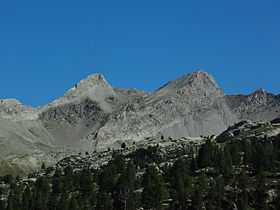Massif des Trois-Évêchés
| Massif des Trois-Évêchés | |
|---|---|
|
Summit view of the Three Bishoprics (2818 m) and Dent des Évêchés (2771 m) from the northwest | |
| Highest point | |
| Peak | Tête de l'Estrop |
| Elevation | 2,961 m (9,715 ft) |
| Geography | |
|
<div style="padding:2px 2px 5px 2px;>  The Massif des Trois-Évêchés is at the lower centre | |
| Country | France |
| Region | Provence-Alpes-Côte d'Azur |
| Departement | Alpes-de-Haute-Provence |
| Range coordinates | 44°17′N 6°32′E / 44.28°N 6.53°ECoordinates: 44°17′N 6°32′E / 44.28°N 6.53°E |
| Geology | |
| Type of rock | Sedimentary rock |
Massif des Trois-Évêchés (Occitan: Massís dei Tres Eveschats, literally the massif of the Three Bishoprics) is a mountain range in the Provence Alps and Prealps in Alpes-de-Haute-Provence, France. Its name comes from the central summit of the massif, the Pic des Trois-Évêchés (so named because it marked the boundary between the dioceses of Digne, Embrun and Senez) where there are ridges to the north, west and south. The highest peak is the Tête de l'Estrop, at 2,961 metres (9,715 ft).
Geography
The massif in the broadest sense extends from north to south between the Bes to the west, the Ubaye in the north, the Verdon to the east and the Asse (approximately) to the south. It is also crossed by the Bléone and the Vallon du Laverq.
It is surrounded to the north by the Massif du Parpaillon, east by the Massif du Pelat, south-east by the Préalpes de Castellane and finally to the south and to the west by the Préalpes de Digne (which some southern peaks, or even the whole massif, are sometimes attached, although significantly higher altitudes, and different orientation).
Main summits
- Tête de l'Estrop, 2,961 metres (9,715 ft), the highest point of the massif
- Grande Séolane, 2,909 metres (9,544 ft)
- Petite Séolane, 2,854 metres (9,364 ft)
- Trois-Évêchés, 2,818 metres (9,245 ft)
- Tête de Chabrière, 2,745 metres (9,006 ft)
- Roche Close, 2,739 metres (8,986 ft)
- Sommet du Caduc, 2,654 metres (8,707 ft)
- Mourre-Gros, 2,652 metres (8,701 ft)
- Montagne de la Blanche, 2,610 metres (8,560 ft) : Bernardez, Neillère, l'Aiguillette
- Les Mées, 2,599 metres (8,527 ft)
- Tête de la Sestrière, 2,572 metres (8,438 ft)
- Tête Noire, 2,560 metres (8,400 ft)
- Sangraure, 2,560 metres (8,400 ft)
- Dormillouse, 2,505 metres (8,219 ft)
- Sommet du Tromas, 2,500 metres (8,200 ft)
- Autapie, 2,426 metres (7,959 ft)
- Sommet de Denjuan, 2,403 metres (7,884 ft)
- Gros Tapy, 2,374 metres (7,789 ft)
- Grand Croix, 2,369 metres (7,772 ft)
- Montagne du Cheval Blanc, 2,323 metres (7,621 ft)
The Montagne de Cordœil, of a more modest size and elevation [2,114 metres (6,936 ft)], is completely isolated from the rest of the massif, the Verdon to the east and the Issole to the north and west.
Geology
The massif of the Trois-Évêchés consists of sedimentary rock, mostly sandstones and marls, typical of the pre-Alps. The geological nature of the north of the massif relates to the Ubaye Valley.
Plane Crash
On 24 March 2015, Germanwings Flight 9525 crashed into the massif.[1][2]
Activities
Winter sports
Canyoning
The massif contains, amongst others, two canyoning descents of high and exceptional level: Male Vasudevan and Bussing.
See also
- Haute Bléone Valley
- Geography of the Western Alps
Bibliography
- Leclerc, Didier (1984). Aux quatre vents des Trois-Évêchés : ballades photographiques dans les hautes vallées des Alpes de Provence [To the four winds of the Trois-Évêchés: photographic walks in the high valleys of the Alps of Provence] (in French). ISBN 2950058604.
- Caracal; Panza, Sancho (2006). Male Vesse, récit et 12 descentes de canyons dans le pays dignois [Male Vesse, narrative and 12 descents of canyons in Digne] (in French). ISBN 2-9526064-0-4.
References
- ↑ Open Sources. 25 March 2015. BBC News.
- ↑ (French) Léo Barnier (24 March 2015). "Un Airbus A320 de Germanwings s'écrase dans les Alpes (MAJ)". Air & Cosmos.
